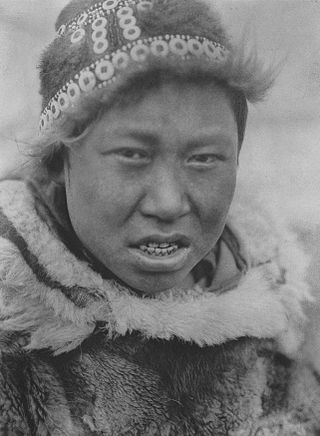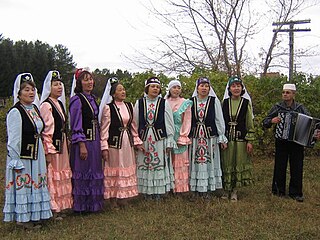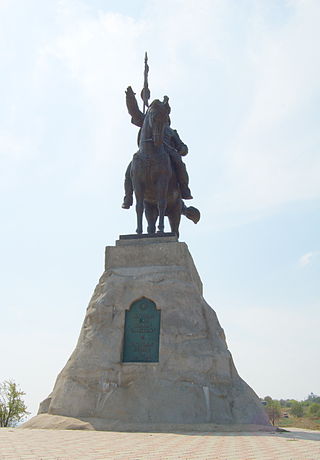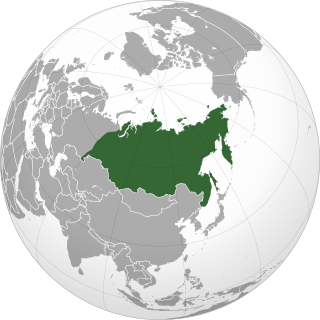
The Turkic languages are a language family of more than 35 documented languages, spoken by the Turkic peoples of Eurasia from Eastern Europe and Southern Europe to Central Asia, East Asia, North Asia (Siberia), and West Asia. The Turkic languages originated in a region of East Asia spanning from Mongolia to Northwest China, where Proto-Turkic is thought to have been spoken, from where they expanded to Central Asia and farther west during the first millennium. They are characterized as a dialect continuum.

The Yupik are a group of Indigenous or Aboriginal peoples of western, southwestern, and southcentral Alaska and the Russian Far East. They are related to the Inuit and Iñupiat. Yupik peoples include the following:

Tatar is a Turkic language spoken by the Volga Tatars mainly located in modern Tatarstan, as well as Siberia. It should not be confused with Crimean Tatar or Siberian Tatar, which are closely related but belong to different subgroups of the Kipchak languages.
The Red Book of the Peoples of the Russian Empire is a book about the small nations of the Russian Empire, the Soviet Union, and Russia and some other post-Soviet states of today. It was published in Estonian in 1991 and in English in 2001.

Sirenik Yupik, Sireniki Yupik, Sirenik, or Sirenikskiy is an extinct Eskimo–Aleut language. It was spoken in and around the village of Sireniki (Сиреники) in Chukotka Peninsula, Chukotka Autonomous Okrug, Russia. The language shift has been a long process, ending in total language death. In January 1997, the last native speaker of the language, a woman named Vyjye, died. Ever since that point, the language has been extinct; nowadays, all Sirenik Eskimos speak Siberian Yupik or Russian.

The Yupik languages are a family of languages spoken by the Yupik peoples of western and south-central Alaska and Chukotka. The Yupik languages differ enough from one another that they are not mutually intelligible, although speakers of one of the languages may understand the general idea of a conversation of speakers of another of the languages. One of them, Sirenik, has been extinct since 1997.

The Besermyan, Biserman, Besermans or Besermens are a numerically small Permian people in Russia.

Siberian Tatars or Sybyrs/Sibirs are the indigenous Turkic-speaking population of the forests and steppes of Western Siberia, originating in areas stretching from somewhat east of the Ural Mountains to the Yenisey River in Russia. The Siberian Tatars call themselves Yerle Xalıq, to distinguish themselves from more recent Volga Tatar immigrants to the region.

Teleuts are a Turkic Indigenous people of Siberia living in Kemerovo Oblast, Russia. According to the 2010 census, there were 2,643 Teleuts in Russia. They speak the Teleut language/dialect of Southern Altai language.

Of all the languages of Russia, Russian, the most widely spoken language, is the only official language at the national level. There are 35 other official languages, which are used in different regions of Russia. These languages include; Ossetic, Ukrainian, Buryat, Kalmyk, Chechen, Ingush, Abaza, Adyghe, Cherkess, Kabardian, Altai, Bashkir, Chuvash, Crimean Tatar, Karachay-Balkar, Khakas, Nogai, Tatar, Tuvan, Yakut, Erzya, Komi, Hill Mari, Meadow Mari, Moksha, and Udmurt. There are over 100 minority languages spoken in Russia today.

Bulgarism is an ideology aimed at the "revival of Bulgars' national identity" and Volga Bulgaria statehood. It originated in the second half of 19th century within the Wäisi movement and the Society for the study of the native land (Chuvashia) It was revived at the end of the 20th century as "neobulgarism" in Tatarstan, Bashkortoston and Chuvashia.

The Russian conquest of Siberia took place during 1580–1778, when the Khanate of Sibir became a loose political structure of vassalages that were being undermined by the activities of Russian explorers. Although outnumbered, the Russians pressured the various family-based tribes into changing their loyalties and establishing distant forts from which they conducted raids. It is traditionally considered that Yermak Timofeyevich's campaign against the Siberian Khanate began in 1580. The annexation of Siberia and the Far East to Russia was resisted by local residents and took place against the backdrop of fierce battles between the Indigenous peoples of Siberia and the Russian Cossacks, who often committed atrocities against Indigenous Siberians.

Siberia is a vast region spanning the northern part of the Asian continent and forming the Asiatic portion of Russia. As a result of the Russian conquest of Siberia and of the subsequent population movements during the Soviet era (1917–1991), the modern-day demographics of Siberia is dominated by ethnic Russians (Siberiaks) and other Slavs. However, there remains a slowly increasing number of Indigenous groups, accounting for about 5% of the total Siberian population, some of which are closely genetically related to Indigenous peoples of the Americas.
Sirenik or Sireniki are former speakers of a divergent Eskimo language in Siberia, before its extinction. The total language death of this language means that now the cultural identity of Sirenik Eskimos is maintained through other aspects: slight dialectal difference in the adopted Siberian Yupik language; sense of place, including appreciation of the antiquity of their settlement Sirenik.

The Volga Finns are a historical group of peoples living in the vicinity of the Volga, who speak Uralic languages. Their modern representatives are the Mari people, the Erzya and the Moksha Mordvins, as well as speakers of the extinct Merya, Muromian and Meshchera languages. The Permians are sometimes also grouped as Volga Finns.

Indigenous peoples of the Subarctic are the aboriginal peoples who live in the Subarctic regions of the Americas, Asia and Europe, located south of the true Arctic at about 50°N to 70°N latitude. This region includes the interior of Alaska, the Western Subarctic or western Canadian Shield and Mackenzie River drainage area, the Eastern Subarctic or Eastern Canadian Shield, and most of Fennoscandia, Northwestern Russia and Siberia. Peoples of subarctic Siberia and Greenland are included in the subarctic; however, Greenlandic Inuit are usually classified as Indigenous peoples of the Arctic.
Astrakhan Tatars are an ethnic subgroup of the Tatar.














